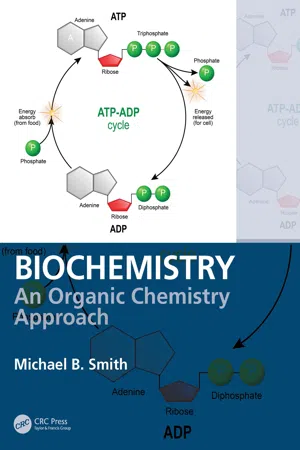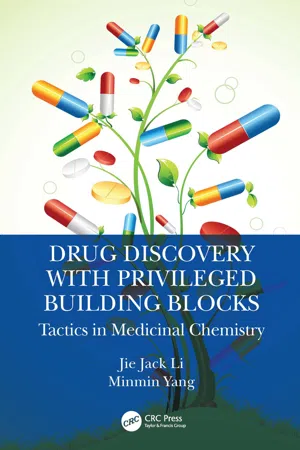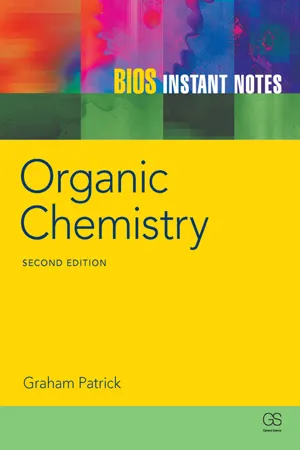Chemistry
Benzopyran
Benzopyran is a chemical compound consisting of a benzene ring fused to a pyran ring. It is a heterocyclic compound with important biological and pharmacological properties. Benzopyrans are found in various natural products and are known for their diverse range of activities, including antioxidant, anti-inflammatory, and anticancer properties.
Written by Perlego with AI-assistance
Related key terms
1 of 5
4 Key excerpts on "Benzopyran"
- eBook - ePub
Biochemistry
An Organic Chemistry Approach
- Michael B. Smith(Author)
- 2020(Publication Date)
- CRC Press(Publisher)
N- oxide. Pyrazinamide (pyrazine-2-carboxamide) is an antibacterial agent.The pyrimidine ring system is found in thiamin (known as vitamin B1 ). A deficiency of thiamin is associated with Beriberi. Symptoms of Beriberi include loss of appetite and fatigue, digestive irregularities, and a feeling of numbness and weakness in the limbs and extremities that may lead to nerve degeneration in extreme cases. Another pyrimidine, sulfamerazine, is a broad-spectrum antibacterial agent. Minoxidil (Rogaine) is classified as a vasodilator used to treat high blood pressure, but it is also used in hair-restoring preparations. A vasodilator relaxes the smooth muscle in blood vessels, causing the vessels to dilate.There are five-membered ring aromatic compounds that contain an oxygen or a sulfur, but the analogous six-membered ring compounds are not aromatic. Furan is an aromatic compound that is distilled from pine wood rosin and its vapors are narcotic. As shown in Figure 9.19 , one of the two electron pairs on oxygen is involved in the aromatic π-cloud (those two electrons are needed to make a total of six), but the other lone electron pair is perpendicular to the π-cloud. Therefore, furan can function as a base and it should be a stronger base than pyrrole because of the availability of those electrons. While furan is a somewhat stronger base than pyrrole, it is generally categorized as a weak base. Furan is an aromatic ether and the furan ring plays a prominent role in many naturally occurring and synthetic compounds.FIGURE 9.19 Furan, thiophene and pyran.If the oxygen atom is replaced with sulfur, the resulting compound is the aromatic compound thiophene, which is an aromatic thioether. As with furan, one electron pair is involved in the 6 π-electron aromatic cloud, and the other is perpendicular to that π-cloud. Thiophene is a weaker base than furan. Oxygen is divalent, so incorporation into a neutral six-membered ring does not allow an aromatic system to be generated but the nonaromatic pyran is well known. Indeed, pyran is the six-membered ring analog, but for oxygen to remain neutral, one carbon must be sp3 - eBook - ePub
Drug Discovery with Privileged Building Blocks
Tactics in Medicinal Chemistry
- Jie Jack Li, Minmin Yang(Authors)
- 2021(Publication Date)
- CRC Press(Publisher)
20 Pyrazines
Structurally, pyrazine is a planar hexagon, similar to benzene, in both bond angles and lengths. Its C–N bonds are shorter and C–N–C bond angles are smaller than their phenyl counterparts.Pyrazine’s Bond Lengths and AnglesWith six π-electrons, pyrazine is an electron-deficient (also known as electron-poor) aromatic heterocycle because of the increased electronegativity of the nitrogen atoms. Due to the presence of the electronegative nitrogen atoms, the electron density on the ring carbons is less than one. The lone-pair electrons do not take part in the delocalization for aromaticity, so this molecule can act as a mild base. Its pKa1 = 0.65 and pKa2 = 5.78. Basic dissociation constants (pKa1 ) of pyrazine, some pyrazine derivatives, and other diazines are listed above.1Pyrazine-Containing Drugs
There are approximately eight pyrazine-containing drugs on the market in the US. For instance, Pfizer’s glipizide (Glucotrol, 1) is an old sulfonylurea antidiabetic, which works by stimulating insulin secretion to metabolize carbohydrates. Its mechanism of action (MOA) is serving as a potassium channel blocker.Vertex’s bortezomib (Velcade, 2) was the first proteasome inhibitor approved to treat relapsed multiple myeloma (MM) and mantle cell lymphoma. Mechanistically, the boron atom binds, with high affinity and specificity, to the catalytic site of the 26S proteasome, which maintains the immortal type of myeloma.Rhone–Poulenc Rorer’s older sleeping pill, zopiclone (Imovane, 3), functions as a GABAA modulator. It is no longer available in the US because of its dubious benefit/risk profile. Having realized that the S-enantiomer is significantly more active and less toxic than the R-enantiomer, Separacor separated them and arrived at eszopiclone (Lunesta, 4), the S - eBook - ePub
- J Fisher, J.R.P. Arnold, Julie Fisher, John Arnold(Authors)
- 2020(Publication Date)
- Taylor & Francis(Publisher)
Section K - Aromatic CompoundsPassage contains an image
K1 Aromaticity
DOI: 10.1201/9780203079522-43Key NotesBenzeneBenzene is an unsaturated molecule and, as such, would be expected to undergo reactions similar to those of other unsaturated hydrocarbons such as alkenes and alkynes. However, benzene is relatively inert, and when it does react favors substitution reactions over addition reactions. The unexpected chemical and physical properties of benzene may be explained by the concept of pi electron delocalization. Benzene is the classic example of an aromatic compound. The term aromatic is applied as benzene, and other ring systems that have similar delocalized pi systems, is fragrant.Molecular orbital description of benzeneBenzene is a planar molecule in which all of the bond angles about the carbon atoms are 120°. This bond angle is what would be expected for an sp2 hybridized carbon atom, and therefore means that at each of the six carbon atoms there is a singly occupied p-orbital. These p-atomic orbitals overlap to form six pi molecular orbitals. The molecular orbital picture of benzene helps explain the special stability of this molecule.Definition of aromaticityIn 1931 the physicist Erich Hückel carried out a series of calculations based on the molecular orbital picture of benzene, but extended this to cover all planar monocyclic compounds in which each atom had a p-orbital. The results of his work suggested that all such compounds containing (4n + 2) pi electrons should be stabilized through delocalization and therefore should also be termed aromatic.Related topics(I3) Factors affecting reactivity (K2) Natural aromatics Benzene
The study of the class of compounds now referred to as aromatics began in 1825 with the isolation of a compound, now called benzene, by Michael Faraday. At this time the molecular formula of benzene, C6 H6 , was thought quite unusual due to the low ratio of hydrogen to carbon atoms. Within a very short time the unusual properties of benzene and related compounds began to emerge. During this period, for a compound to be classified as aromatic it simply needed to have a low carbon to hydrogen ratio and to be fragrant; most of the early aromatic compounds were obtained from balsams, resins or essential oils. It was sometime later before Kekulé and coworkers recognized that these compounds all contained a six-carbon unit that remained unchanged during a range of chemical transformations. Benzene was eventually recognized as being the parent for this new class of compound. In 1865 Kekulé proposed a structure for benzene; a six-membered ring with three alternating double bonds (Figure 1 ). However, if such a structure were correct then the addition of two bromine atoms to adjacent carbons would result in the formation of two isomers of 1,2-dibromobenzene (Figure 1 ). Only one compound has ever been found. To account for this apparent anomaly Kekulé suggested that these isomers were in a state of rapid equilibrium (Figure 1 - eBook - ePub
- Graham Patrick(Author)
- 2004(Publication Date)
- Taylor & Francis(Publisher)
SECTION I — AROMATIC CHEMISTRY
I1 Aromaticity
Key Notes
Definition Aromatic compounds such as benzene are more stable than suggested from their structure. They undergo reactions which retain the aromatic ring system, and behave differently from alkenes or polyenes. Hückel rule Aromatic compounds are cyclic and planar with sp 2 hybridized atoms. They also obey the Hückel rule and have (4n + 2) π electrons where n = 1, 2, 3, ... Aromatic systems can be monocyclic or polycyclic, neutral, or charged. Related topic (A4) sp 2 Hybridization Definition
The term aromatic was originally applied to benzene-like structures because of the distinctive aroma of these compounds, but the term now means something different in modern chemistry. Aromatic compounds undergo distinctive reactions which set them apart from other functional groups. They are highly unsaturated compounds, but unlike alkenes and alkynes, they are relatively unreactive and will tend to undergo reactions which involve a retention of their unsaturation. We have already discussed the reasons for the stability of benzene in Section A4 . Benzene is a six-membered ring structure with three formal double bonds (Figure 1a ). However, the six π electrons involved are not localized between any two carbon atoms. Instead, they are delocalized around the ring which results in an increased stability. This is why benzene is often written with a circle in the center of the ring to signify the delocalization of the six π electrons (Figure 1b ). Reactions which disrupt this delocalization are not favored since it means a loss of stability, so benzene undergoes reactions where the aromatic ring system is retained. All six carbon atoms in benzene are sp 2 hybridized, and the molecule itself is cyclic and planar — the planarity being necessary if the 2p atomic orbitals on each carbon atom are to overlap and result in delocalization.Figure 1. Representations of benzene.
Index pages curate the most relevant extracts from our library of academic textbooks. They’ve been created using an in-house natural language model (NLM), each adding context and meaning to key research topics.



